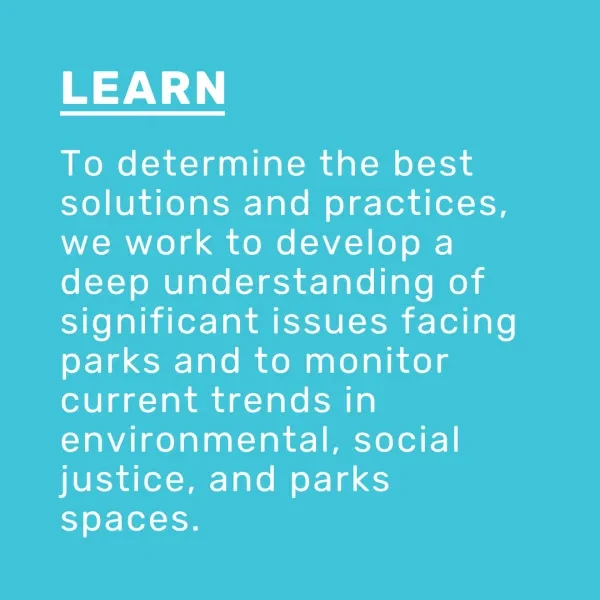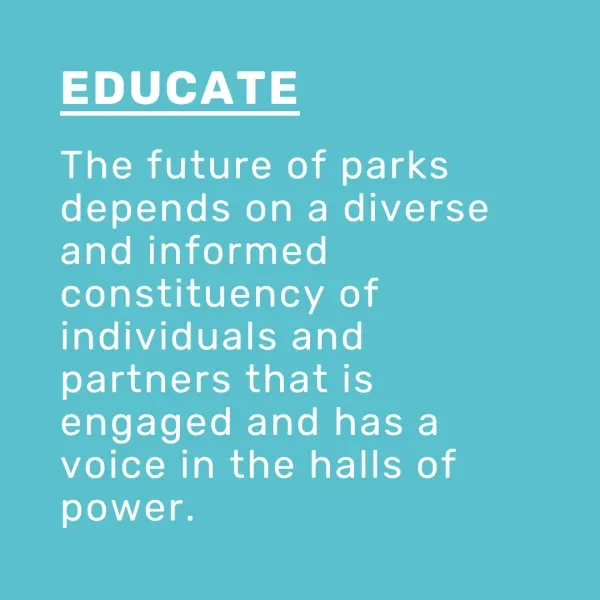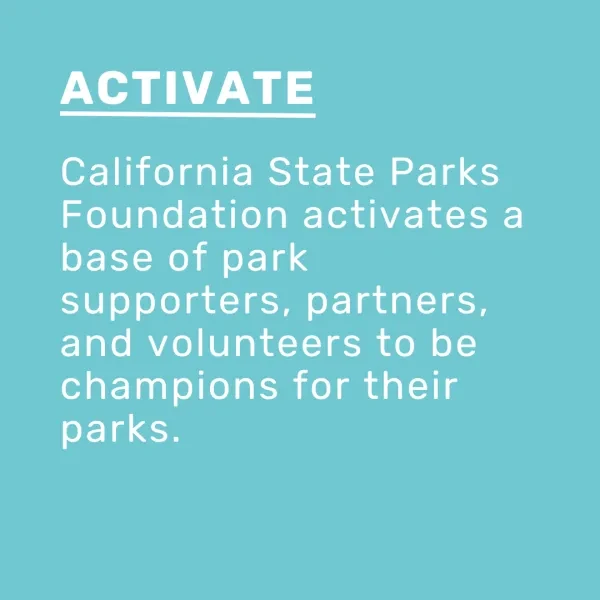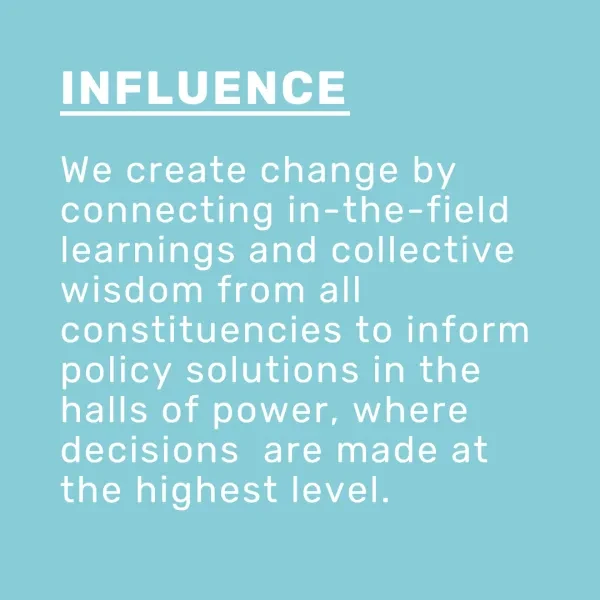We learn from our grantees, park partners, and California State Park staff what kind of models we should invest in to help create the best impact in state parks. For wildfires and grantmaking, learning began in 2020 with our Wildfire Resiliency and Prevention Fund. We’re going into the third year of our wildfire grants with a better understanding that land managers have to consider specific habitat, environmental conditions, and human conditions when building wildfire resilient parks. Our role in helping to fund and scale these models, but we must keep learning to ensure the ideas and projects we are funding and scaling will make the most impact for parks and for California.
One of the most dramatic impacts of a changing climate on the California state park system is the increased occurrences and severity of wildfires. Since the historic 2020 fire season, California State Parks Foundation has been working hand in hand with California State Parks and our park partners to protect and restore our state parks, while supporting models of preparation that help state parks adapt to the growing threat.
The Challenge
In recent years, Californians have experienced the worst wildfires on record. The 2020 California wildfire season was characterized by a record-setting year of wildfires that burned across the state of California as measured during the modern era of wildfire management and record keeping. By the end of 2020, nearly 10,000 fires had burned over 4.2 million acres, more than 4% of the state's roughly 100 million acres of land, making 2020 the largest wildfire season recorded in California's modern history. The 2021 fire season was not far behind in impact on Californians and California state parks. The California Department of Forestry and Fire Protection (CAL FIRE) characterized the 2022 outlook as the following: “California continues to experience longer wildfire seasons as a direct result of climate change. Extended dryness originating from January is expected to continue into the spring with little precipitation, leaving most of the state in moderate to extreme drought conditions prior to summer. These continued dry conditions, with above normal temperatures through spring, will leave fuel moisture levels lower than normal, increasing the potential for wildland fire activity.”.
Our state parks are in uncharted territory with a wildfire season that is becoming longer and more intense each year. There are four factors that when combined make wildfires a major and growing threat to state parks. Those are: ongoing drought has brought the moisture content of plants so low that they ignite easier and burn with higher intensity, years of fire suppression that has allowed the buildup and dead and down fuels, a proliferation of non-native plants that burn rapidly and are less fire resilient, and years of underfunding that have led to scarce staff and resources to steward and manage state parks.
The toll of wildfires on California state parks and the surrounding communities has been enormous. California State Parks staff have logged thousands of hours defending our beloved natural and cultural resources, keeping visitors safe, and working with other agencies and nonprofit partners to ensure our state parks are protected and able to adapt to a changing climate and increased fire threat. California State Parks Foundation has been working closely with California State Parks staff, and other park partners to address the effects of wildfires from funding urgent needs that help in the immediate aftermath of a wildfire to investing in model programs and projects that help keep state parks protected against future events.
Our solution
The combined effects of over 100 years of fires suppression and a drier climate make it impossible to address the threat of wildfires to state parks with a simple solution. Through our work, we are supporting models and approaches that land managers and state parks are using to prepare for wildfires. This, combined with knowledge of how these models work within a specific habitat, environmental, and human conditions, are how California State Parks and California State Parks Foundation are making parks more wildfire resilient. These models include:
-
Use of controlled burning and debris removal to foster a healthy ecosystem and reduce catastrophic wildfires.
-
Restoring native vegetation to landscapes that are overrun with highly flammable and invasive species to increase the native biodiversity that has evolved with fire and can better protect and recover from wildfires.
-
Educating and activating local communities and all Californians in the efforts to build greater resiliency to wildfires and how they can help.
In addition to this work, California State Parks Foundation is investing in and supporting the work of California’s Native tribes in working with California State Parks to expand the influence of their culture and use indigenous land practices as state parks works to address these challenges today and in the future.
Our lasting impact
Every month California State Parks Foundation volunteers are in parks working on projects to build resilience to wildfires. Through our grants program, our partners are leading innovative models that address the urgent needs of their parks and community. Through our government affairs work in Sacramento, we are tracking all legislation and fighting for the best policies and required funding that parks need to accomplish the climate resiliency work at the scale that is needed to truly protect and steward our California State Parks. All this work is only made possible because of our 70,000 members and over 125,000 supporters who donate and amplify our work so that all Californians can continue to enjoy their state parks for generations to come.
A little more on the learn work with wildfires…

A little more on the educate work with wildfires…

The more people understand everything California state parks have to offer and the threats facing them, the more likely they are to act on behalf of them. Whether it is signing a petition, donating, volunteering, partnering with us, or just amplifying messages, we have found people are more likely to engage when they are properly educated on the topic or the work we are specifically doing. Therefore, education is an important part of our theory of change.
We are helping people understand why we needed to protect our parks from wildfires. We do this through blog posts, video, website content, webinars, educational materials, and more. These touch points give our audiences more information on why we are doing this work and the need. We incorporate our Justice, Equity, Inclusion, and Diversity work by ensuring that the content is representative of those impacted by the work, that visual assets are inclusive, and our website is ADA compliant.
Through this educational material, we can meet potential supporters and partners where they are and ensure people understand the need to protect our parks from the threats of wildfires. When taking the time to produce content for this crucial step in our throughline, we have seen a significant increase in participation across platforms and conversions.
A little more on the activate work with wildfires…

California State Parks Foundation’s volunteerism program activates community members in completing critical projects in state parks across California. We are utilizing volunteers at Folsom Powerhouse State Historic Park and Chino Hills State Park to help create fire buffers to build defensible space around park buildings, structures, and trails. This is done by clearing areas of invasive plants, excessive deadwood, and debris that contribute to fuel loads.
We are also utilizing our volunteers for habitat restoration. Some of these workdays focus on invasive species removal at specific restoration sites in the park. This is particularly important because invasive species often are more flammable than native plants that have co-evolved with fire and are often more fire resistant. Other restoration workdays include planting California native plants to increase biodiversity, a key strategy in building resilience to changing climate events. Last fiscal year we planted 10,260 plants at workdays.
A little more on the influence work with wildfires…

We create lasting and statewide change for parks with influence. We take the in-the field learnings and collective wisdom from our partners to inform legislative and budget solutions in Sacramento. As an advocacy organization, we have a responsibility to influence the California Legislature to push for public funding and policies that provide the building blocks for a park system that reflects the needs and values of Californians, particularly those who are the most marginalized.
If we are successful at influencing policy makers we will see positive policy and public investment in the state park system. California continues to battle wildfires each fall, and our state parks are not immune. To address this challenge, we advocated for additional funds for wildfire resilience activities on California State Parks land, and ultimately $20 million was appropriated.
We learn, we educate, we activate, and we influence. While every effort starts at learn, the rest of our through-line approach can be applied with flexibility, informed by the goals we are working to fulfill. Throughout this work we commit to building trust-based partnerships, especially with Tribal Nations and Indigenous peoples, communities of color, people with disabilities, and LGBTQ+ communities as part of our greater work on Justice, Equity, Inclusion, and Diversity.
